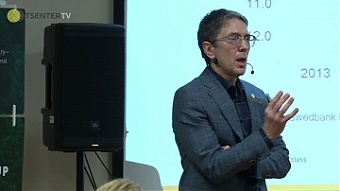Analytics, Banks, Economics, Estonia, Financial Services
International Internet Magazine. Baltic States news & analytics
Tuesday, 23.12.2025, 08:46
Swedbank economist: Outlook for external demand improving
 Print version
Print version |
|---|
According to Statistics Estonia, Estonia's exports of goods
decreased by 25% and imports by 24% in May 2020 compared with the same month a
year ago.
"Unfortunately, the statistics of a month and a half
ago are already too distant history in the context of the current crisis and do
not show the current state of the economy correctly. According to preliminary
estimates, improvement of production activity in several areas of activity can
already be seen in June," Mertsina said.
The exports of goods of Estonian origin decreased by 27% on
year in May and in the first five months of this year, the decline is already
13%. "External demand began to weaken even before the coronavirus crisis.
Exports of goods have been declining already since June last year, there was
extraordinary growth only in December," the economist said.
"Imports of goods, however, fell by 24% on year in May,
with 40% of the decline in imports coming from a decline in imports of inputs
used in production," Mertsina said, adding that, in addition to weakened
demand, the decline in exports and imports has been boosted by falling prices
-- in May, export prices fell by 8% y-o-y and import prices by 9%.
Mertsina said that although exports of most commodity groups
declined, they were the largest in exports of oil products, mobile
communication equipment, prefabricated wooden buildings and wood products.
"The share of these four commodity groups in the
decrease in exports in May was as high as 62%, including the share of oil
products in the extent of 37%. Exports to the countries of the European Union,
which account for 70% of our exports, fell by 27% -- including Finland by 28%,
Sweden by 24% and Germany by 11% --, the United States by 34% and Russia by 3%,"
the economist said.
According to Swedbank's chief economist, the share of
exports of the manufacturing industry, our largest commodity-exporting
industry, in the revenue has decreased in the crisis months of this year
-- while it was an average of 67% in 2019 and 68% in the first quarter of
this year, it fell to 64% in April.
"In May, the share of manufacturing export revenue
increased to 66%. At the same time, it should be taken into account that the
value chain related to exports in Estonia is significantly greater than the
share of the export revenue of the manufacturing industry or the share of goods
in GDP with 48% indicates," Mertsina said, adding that, according to a
study commissioned by the Foresight Center, 29% of Estonian companies export
directly, but 80% are up to two transaction partners away from exporting.
"Thus, foreign demand affects most of the Estonian
business sector," he said.
According to Mertsina, purchasing managers indexes, which
characterize economic activity, have improved rapidly in the euro area since
the low point in April and it reached the level of the beginning of this year
in the manufacturing industry in June.
"Purchasing managers indexes have also improved in the
United States and China. This indirectly indicates that the decline in external
demand has bottomed out and is gradually improving. Although the outlook for
industrial production volumes in Estonia improved sharply in June, the outlook
for exports remained at the very low level reached already in April," the
economist said.
He added that companies' assessment of export orders
improved marginally and is still far from the pre-crisis period, not to mention
the last peak in 2017.
"Employment in the Estonian manufacturing industry has
gradually started to improve. Although it is still declining on an annual
basis, then in June, it was already slightly up on a weekly basis,"
Mertsina said.
He pointed out that at the same time, it should be taken
into account that approximately 28% of those employed in the manufacturing
industry received wage compensation from the Unemployment Insurance Fund as of
the beginning of July.
"Its end could deal another blow to employment in this
industry if demand and prices do not improve fast enough," Swedbank's
chief economist said.
- 25.01.2021 Как банкиры 90-х делили «золотую милю» в Юрмале
- 29.12.2020 В Латвии вводят комендантский час, ЧС продлена до 7 февраля
- 29.12.2020 В Rietumu и в этот раз создали особые праздничные открытки и календари 2021
- 29.12.2020 Latvia to impose curfew, state of emergency to be extended until February 7
- 29.12.2020 Lithuanian president signs 2021 budget bill into law
- 29.12.2020 Number of new companies registered in Estonia up in 2020
- 29.12.2020 Президент Литвы утвердил бюджет 2021 года
- 28.12.2020 Рынок недвижимости Эстонии осенью начал быстро восстанавливаться
- 28.12.2020 Tartu to support students' solar car project
- 28.12.2020 New Year Cards and Calendars of Rietumu Bank presented








 «The Baltic Course» Is Sold and Stays in Business!
«The Baltic Course» Is Sold and Stays in Business!

